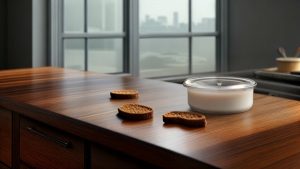Keeping your kitchen cabinets clean and free from grease and grime is essential for both the appearance and hygiene of your home. However, removing grease buildup from cabinets can seem like a daunting task. With these simple steps and tips, you can easily degrease your kitchen cabinets and keep them looking their best.
Key Takeaways:
- Regularly degreasing your kitchen cabinets is important for maintaining cleanliness and shine in your home.
- There are both commercial and natural solutions available for degreasing kitchen cabinets.
- Proper ventilation and preparation are key to a successful and safe degreasing process.
Why Degreasing Your Kitchen Cabinets is Important
When it comes to maintaining a clean and hygienic kitchen, degreasing your cabinets should be a top priority. Over time, the buildup of grease and grime on your cabinets can not only make your kitchen look dingy and unkempt, but it can also create a breeding ground for bacteria and germs.
While it may seem like a daunting task, regular degreasing of your kitchen cabinets can actually be a relatively easy and manageable process. By following some simple kitchen cabinet degreasing techniques and implementing the best ways to clean greasy kitchen cabinets, you can keep your kitchen looking sparkling clean and free of harmful bacteria.
Removing grease buildup from kitchen cabinets is also important for maintaining the appearance and longevity of your cabinets. Grease and grime can cause damage and discoloration to the wood or laminate of your cabinets, leading to costly repairs or replacement down the line.
Materials Needed for Degreasing Kitchen Cabinets
Before starting the degreasing process, gather the following materials:
- Kitchen degreaser spray or a natural alternative, such as vinegar or baking soda
- Dish soap
- Warm water
- Clean microfiber cloths or sponges
- Bowl or bucket
For those who prefer natural methods to remove grease from cabinets, DIY cabinet degreasing solutions are a great option. A mixture of white vinegar and warm water is a popular solution. Simply mix equal parts of vinegar and warm water in a bowl or bucket, soak a microfiber cloth or sponge in the solution, and use it to wipe down the cabinets. Baking soda and dish soap are other common natural degreasers that can be used in combination with warm water to remove grease buildup from kitchen cabinets.
Alternatively, eco-friendly methods for degreasing cabinets include using a steam cleaner or a mixture of lemon juice and baking soda. These options are gentle on the environment and effective at removing grime and grease buildup.
Preparation Before Starting the Degreasing Process
Kitchen cabinet cleaning requires preparation beforehand to prevent any damage to surfaces and ensure a smooth degreasing process. Follow these steps before starting the degreasing process:
- Clear Out the Cabinets: Remove all items from the cabinets before starting the degreasing process. This will make it easier to access all areas of the cabinets and prevent any items from getting in the way.
- Protect Surfaces: Cover the surrounding surfaces with plastic or newspaper to protect them from any cleaning products or grease that may splash or drip during the degreasing process.
- Ventilate the Area: Ensure that the kitchen area is properly ventilated by opening windows or turning on a fan. This will help to prevent any harmful fumes from cleaning products and ensure the area is well-ventilated.
- Remove Stubborn Stains: If there are any stubborn stains on the cabinets, use a non-abrasive cleaner to remove them before beginning the degreasing process. This will make the degreasing process more effective and efficient.
By following these steps, you can ensure that the kitchen cabinets are properly prepared for the degreasing process and that cleaning them will be easy and effective.
Step-by-Step Guide: How to Degrease Your Kitchen Cabinets
Degreasing kitchen cabinets can seem like a daunting task, but with the right tools and techniques, it can be a straightforward process. Follow these steps to effectively remove grease buildup from your cabinets:
- Remove all items from the cabinet. This will make it easier to access all areas of the cabinet and ensure that no items get in the way of the degreasing process.
- Protect surrounding surfaces. Cover countertops and floors with newspaper or a drop cloth to prevent any cleaning solution from staining or damaging them.
- Ensure proper ventilation. Open windows or turn on a fan to provide adequate ventilation while cleaning. This will prevent any harmful fumes from building up in the kitchen.
- Choose the right cleaning solution. For wooden cabinets, mix a solution of warm water and mild dish soap. For laminate or painted cabinets, use a solution of warm water and vinegar.
- Dip a clean cloth in the cleaning solution and wring out any excess liquid. Use the damp cloth to wipe down the cabinets, starting from the top and working your way down. Pay particular attention to areas with heavy grease buildup, such as around the stove or sink.
- Rinse the cloth and wipe down the cabinets again with clean water to remove any remaining cleaning solution.
- Dry the cabinets with a clean towel or allow them to air dry.
For effective ways to remove grease from wooden cabinets, consider using a commercial wood cleaner or a paste made from baking soda and water. Apply the cleaner to the cabinets and wipe with a clean cloth, following the grain of the wood. Rinse with water and dry with a clean towel.
Repeat this process on a regular basis to prevent grease buildup and maintain the appearance of your kitchen cabinets.
Cleaning and Maintaining Cabinet Hardware
When degreasing your kitchen cabinets, it’s important not to forget about the hardware. Overtime, handles, knobs, and hinges can become greasy and dirty, detracting from the overall appearance of your cabinets. Here are some simple steps for cleaning and maintaining your cabinet hardware:
- Remove the hardware: Before cleaning, remove the hardware from your cabinets. Use a screwdriver to unscrew any screws and gently pull the hardware away from the cabinet.
- Soak in hot, soapy water: Fill a sink or basin with hot, soapy water and let the hardware soak for 10-15 minutes to loosen any dirt or grime.
- Scrub with a soft-bristled brush: Use a soft-bristled brush to gently scrub the hardware, removing any remaining grease and grime. Avoid using abrasive materials that could scratch or damage the hardware.
- Rinse and dry: Rinse the hardware with clean water to remove any soap residue, then dry thoroughly with a clean towel.
- Reattach the hardware: Once the hardware is clean and dry, reattach it to the cabinet using the screws you removed earlier.
By taking the time to properly clean and maintain your cabinet hardware, you can help ensure that your kitchen cabinets look their best and remain in good condition over time.
Tips for Preventing Grease Buildup in the Future
To avoid the hassle of degreasing your kitchen cabinets frequently, it is essential to take preventive measures. Here are some tips that will help prevent grease buildup in the future:
- Regular Cleaning: Regularly cleaning your kitchen cabinets is the best way to prevent grease buildup. Use warm water and a mild detergent to wipe down the cabinets and remove any grime or grease. Avoid using abrasive sponges or cleaners that can scratch the surface of the cabinets.
- Proper Ventilation: Proper ventilation is crucial in preventing grease buildup. Improve airflow in your kitchen by using exhaust fans or opening windows when cooking.
- Avoid Greasy Foods: Try to avoid cooking greasy foods that can splatter and accumulate on your kitchen cabinets. Use splatter screens or lids when frying foods to prevent grease from spreading around the kitchen.
- Use Paper Towels: If you have spills or splatters on your cabinets, clean them up right away using paper towels. This will prevent the grease from settling and becoming more difficult to remove later on.
- Choose the Right Cleaning Products: When selecting cleaning products for your kitchen cabinets, choose ones specifically designed for removing grease. Avoid harsh chemicals that can damage the surface of the cabinets.
By implementing these tips, you can easily prevent grease buildup on your kitchen cabinets and keep them looking clean and shiny for longer periods of time.
Eco-Friendly Alternatives for Cabinet Degreasing
While commercial cleaning products can effectively remove grease from cabinets, they often contain harsh chemicals that can be harmful to both the environment and your health. Fortunately, there are several natural methods and DIY solutions that can help you degrease your kitchen cabinets in an eco-friendly way.
Natural methods to remove grease from cabinets:
Vinegar: Mix equal parts of white vinegar and water in a spray bottle. Spray onto the greasy areas of the cabinet and wipe with a microfiber cloth. Rinse the cloth and repeat until the grease is removed.
Baking soda: Mix baking soda and water to form a thick paste. Apply the paste to the greasy areas of the cabinet and let it sit for a few minutes. Scrub with a soft-bristled brush and wipe with a damp cloth.
Lemon juice: Cut a lemon in half and rub the cut side over the greasy areas of the cabinet. Wipe with a damp cloth to remove the grease and leave a fresh scent.
DIY cabinet degreasing solutions:
Dish soap and water: Mix a few drops of dish soap with warm water in a spray bottle. Spray onto the greasy areas of the cabinet and wipe with a microfiber cloth. Rinse the cloth and repeat until the grease is removed.
Olive oil and baking soda: Mix equal parts of olive oil and baking soda to form a thick paste. Apply the paste to the greasy areas of the cabinet and let it sit for a few minutes. Scrub with a soft-bristled brush and wipe with a damp cloth.
Eco-friendly methods for degreasing cabinets:
Steam cleaning: Use a handheld steam cleaner to blast away grease and grime from your cabinets. This method is not only eco-friendly but also effective in killing bacteria and germs.
Microfiber cloths: Use microfiber cloths to wipe away grease and dirt from your cabinets. These cloths are washable and reusable, reducing waste and saving money on paper towels.
By using these natural, DIY, and eco-friendly methods, you can effectively degrease your kitchen cabinets without negatively impacting the environment or your health.
Conclusion
In conclusion, knowing how to degrease your kitchen cabinets is crucial for maintaining a clean and hygienic kitchen. By regularly removing grease buildup, you can prevent the accumulation of grime and maintain the appearance of your cabinets.
To effectively degrease your kitchen cabinets, it is important to use the proper materials and cleaning products. This can include both commercial options and natural, DIY solutions. In addition, it is essential to properly prepare your cabinets before starting the degreasing process and to follow a step-by-step guide for best results.
By following the tips and tricks discussed in this article, you can not only clean your cabinets but also maintain their cleanliness in the future. Additionally, eco-friendly alternatives can help you achieve a grease-free kitchen without the use of harsh chemicals.
Don’t let greasy kitchen cabinets bring down the appearance of your home. Take action and degrease your cabinets today using the techniques discussed in this article.
FAQ
Q: Why is it important to degrease kitchen cabinets?
A: Degreasing kitchen cabinets is important for preventing the buildup of grime, maintaining the appearance of the cabinets, and ensuring a hygienic kitchen environment.
Q: What materials do I need for degreasing kitchen cabinets?
A: To effectively degrease kitchen cabinets, you will need cleaning products such as dish soap, vinegar, baking soda, microfiber cloths, a sponge or soft-bristle brush, and gloves.
Q: How do I prepare the cabinets before starting the degreasing process?
A: Before degreasing the kitchen cabinets, remove any items from inside the cabinets, protect surrounding surfaces with towels or plastic sheets, and ensure proper ventilation by opening windows or using a fan.
Q: What are the steps to degrease kitchen cabinets?
A: To degrease kitchen cabinets, start by mixing a solution of warm water and dish soap. Apply the solution to the cabinets using a sponge or soft-bristle brush, scrubbing gently. Rinse with clean water and dry thoroughly.
Q: How do I clean and maintain cabinet hardware?
A: To clean and maintain cabinet hardware, remove them from the cabinets and soak them in warm, soapy water. Scrub off any grease or grime, rinse with clean water, and dry thoroughly before reattaching to the cabinets.
Q: How can I prevent grease buildup in the future?
A: To prevent grease buildup on kitchen cabinets, ensure proper ventilation in the kitchen, clean the cabinets regularly using mild cleaning solutions, and avoid using greasy or oily products near the cabinets.
Q: Are there any eco-friendly alternatives for degreasing cabinets?
A: Yes, there are eco-friendly alternatives for degreasing cabinets. Natural ingredients such as vinegar, baking soda, and lemon juice can be used to effectively remove grease without the use of harsh chemicals.

It’s me, Amber Hayden, the heart and soul behind SagarmathaOnlineMedia.com. From a young age, I’ve been head over heels for everything home-related, from interior decor to gardening. I’m the type who can’t resist a well-crafted piece of furniture, and I firmly believe that a home isn’t complete without a pet or two. But it’s not just about creating pretty spaces for me. I’m all about making homes that tell a story reflecting the people living there. SagarmathaOnlineMedia.com is my way of sharing this passion with you. Whether you’re looking for tips to jazz up your living room, advice on pet care, or ideas to make your garden bloom, I’m here to help. So, let’s embark on this journey together and make your house a home!



